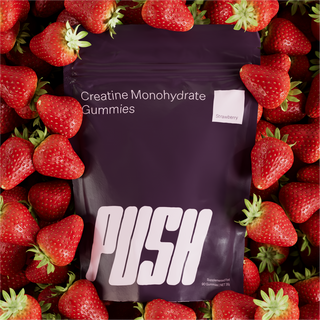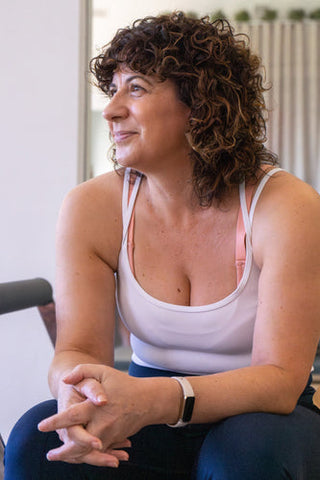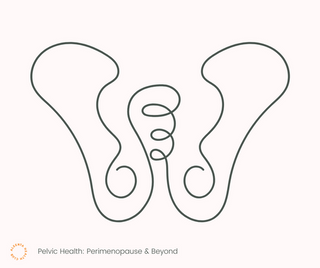Need a refresh? Check out our blog on What is pelvic health?
The World Health Organisation says, “It’s critical to see menopause as just one point in a continuum of life stages” (i).
“Let’s be honest – if you’ve got a uterus, you’re in for it. But with a bit of knowledge, some expert advice and support from good folk around you, as well as a reduction in the shame and stigma, I reckon we’re all in for a better time of it. And you know what? We deserve that.” – Myf Warhurst, Australian media icon

Perimenopause is an incredible natural process but rarely a comfortable one.
The cascade of chemical changes that signals you’re moving on from the reproductive stage of life affects your pelvic organ microbiome (ii), pelvic floor muscle strength (iii), and even the bone structure of your pelvis (iv).
It’s a bit to take in.
Glide Physio & Pilates boss Ellie Parnell walks you through why pelvic health is vital to your overall wellbeing, when to see a professional, and different ways to manage your symptoms.

What is perimenopause?
Perimenopause captures the process that leads up to the official “menopause” milestone (congratulations!) defined as 12 months after your last ever period.
When your egg reserves get low, usually in your mid-40s (v), your clever body decides it’s time for the ovaries to slow down – and eventually stop – producing the levels of oestrogen that help drive the reproductive cycle.
But before the big oestrogen drop, it fluctuates (vi). A lot. This can mess with your cycle clock (one of the first symptoms you may notice), your perception of temperature, mood regulators, sleep timer, metabolism … we could go on.
Perimenopause lasts, on average, 4-6 years. According to Healthdirect, about 60% of women report mild to moderate symptoms, and 20% report severe symptoms that disrupt daily life (vii).

Is perimenopause changing your pelvic health?
Enter, physiotherapist Ellie Parnell.
“Along with a shorter or erratic menstrual cycle, you may notice sex is painful(viii) – or you have decreased libido or enjoyment during sex – bowel issues, or bladder discomfort,” Ellie says.
“Symptoms largely can be traced back to the decrease in oestrogen production.”
Ellie says this is because before perimenopause oestrogen does more than help regulate your reproductive cycle.
Oestrogen is vital to:
-
Blood circulation to your your inner pelvic organs, muscles and fascia (ix)
-
Libido levels (x)
-
Distribution of fatty tissue stores in your body (xi)
-
Collagen production (xii)
-
Bone strength and joint health
When oestrogen levels change beyond your body’s recognisable norm (xiii), these things can be disrupted, altering your pelvic and overall health.
Less oestrogen can result in:
-
Less vaginal lubrication (causing dryness), smoothing and thinning of the vaginal walls (less folds & elasticity) and skin fragility, which can cause tearing & capillary damage
-
An itchy vulva (often mistaken for thrush)
-
Weakness in pelvic floor and inner pelvic muscles, fascia and ligaments, which can cause urinary incontinence and/or pelvic organ prolapse
-
Altered pelvic organ microbiome increasing susceptibility to UTIs, and
-
General pelvic or lower back pain
A quick note about oestrogen.
This wonder hormone doesn’t just disappear from your body forever with your last cycle but your ovaries hand over the reins to your adrenal glands (xiv).
Your body then turns hormones called “androgens” into oestrogen – there’s just not as much of it in your bloodstream once the ovaries are on permanent vay-cay, so balancing the functions that oestrogen once assisted requires a bit of extra support.

Can pelvic health affect your overall wellbeing in perimenopause?
Ellie says it’s important to understand that physical, psychological and emotional health are deeply interconnected (xv).
“Pelvic health symptoms can change how we feel about ourselves and intimacy, exercise and even work,” she says, “and we really need a strong sense of love, support and connection to hold onto if things get wobbly.
“Learning about the biology and potential symptoms, to get comfortable talking about it with your support people, and form healthy habits before perimenopause begins, can help the transition (xvi).
"If you’re in peri or postmenopause, it’s never too late to start communicating and managing your symptoms!”

Are perimenopause symptoms always a problem?
“Absolutely not," says Ellie, "but there's a lot of change that affects your nervous systems and this is commonly unsettling.
"If your symptoms – from pelvic health to memory problems, interrupted sleep or mood swings – stop you doing the things you love, if you’re not enjoying things that usually make you happy, or you struggle to find new ways to feel healthy, then it may be time to see a professional.
“Knowing who to see or where to start can be tricky.
"You can seek help from women’s health GPs or look at the wide range of allied health options available in most metropolitan areas, depending on what’s up."
Physio for perimenopause & pelvic health
Physiotherapy assessments can diagnose conditions, investigate areas of concern, and help you manage symptoms, including stress urinary incontinence, pain during sex, pelvic organ prolapse, and pelvic floor muscle strength.
Academic publications and peak health bodies have well-documented peer-reviewed evidence on the benefits of physiotherapy for pelvic health issues (xvii) – and a new data analysis published by BMC Women’s Health (xviii) shows manual physiotherapy can also help reduce perimenopausal insomnia and depression.
Do pelvic health issues impact your sleep, headspace, relationships, exercise, work or sexy time?
Get on top of it, Book your Initial Physio Assessment with Ellie Parnell, at Aleenta Health Club, 421 Magill Rd, St Morris.
Evidence-based pelvic health management
Clinical Pilates
An excellent option if you aren’t confident in a group Pilates class or have an injury or condition that requires extra care, as a clinical Pilates provider gives close supervision and personalised guidance on the exercises most helpful for you, an appropriate level of resistance, and correct technique to avoid injury.
Pilates helps:
-
Ease aches and pains associated with perimenopause and aging
-
Improve your posture, muscle health and bone density
-
Address body composition changes
-
Facilitate relaxation and manage stress, and
-
Reset the efficiency of your breathing.
Dry needling
Dry needling is a technique used to relieve muscle pain and tension by inserting thin, sterile needles into trigger points – taut bands of muscle fibres that can limit movement and cause discomfort. It can be helpful for conditions including Myofascial Pain Syndrome, muscular tension from chronic pain, and headaches & migraines.
Dry needling helps:
-
Release trigger points
-
Improve circulation, and
-
Stimulate the healing process.
Joint mobilisation & massage
Joint mobilisation is a manual therapy technique used by physiotherapists to improve range of motion and reduce pain in both spinal and peripheral joints (e.g. hips, knees, shoulders). Massage is another tool used to address muscle tension, pain, and restricted movement in muscles, tendons, and ligaments.
These techniques help:
-
Reduce pain
-
Restore range of movement
-
Release muscle tension and
-
Improve circulation.
Moisturise your vagina & use lube!
Seriously.
Ellie says vaginal dryness doesn’t go away on its own.
“Think about all that TLC you've given your face over the years. Now it's time to look after your delicate vagina,” she says. “Evidence suggests moisturisers containing hyaluronic acid (ixx) are the most effective for hydrating the vagina.
Look for water-based, pH neutral, fragrance-free products that do not contain phthalates or parabens** (see references note 1).
Over-the-counter – Vagisil ProHydrate External Hydrating Gel, Olive and Bee Intimate Cream, Yes VM & even KY Jelly, to keep things hydrated, supple and flexible down there, and less prone to tearing and irritation.
Hormone therapy (HRT)
These must be prescribed by a medical doctor who will explain the benefits and risks, and assess if this is an advisable option based on your health.
HRT can make a big difference to the symptoms of menopause including hot flashes, night sweats, vaginal dryness and mood swings. They can also help prevent osteoporosis (xx).
HRT products use a combination of oestrogen and progesterone administered via:
-
a cream or pessary inserted into the vagina
-
a patch on the skin
-
or orally
Exercise & nutrition for lifelong pelvic health
Ellie says along with the above therapies, your movement and food habits impact your pelvic health in perimenopause (xxi).
“If you think about it, your pelvis contains the end of the digestive and filtration systems, so what goes into your body affects your bowel and bladder, which are connected directly and subtly to other pelvic organs,” Ellie says.
“The cardiovascular stress of exercise is obviously good for metabolism relating to digestion but also for the health of your pelvic bones and maintaining supple and strong connective tissues.”
Resistance training
Using weights to encourage bone density and increase muscle mass also maintains your heart health and circulation, beneficial for pelvic organs & tissues; reduces joint pain; and strengthens the muscles around and inside your pelvic bones (xxii).

Food for life
More fibre & low amounts of processed or highly refined foods, and saturated fats, assist digestive health (xxiii).

Hydration
If you think you’re drinking enough water, drink more to keep your blood flow and nerve function moving happily through the organs, muscles and fascia of your pelvis.
How's your bulls% radar?
Supplements. There's a lot of *stuff* out there targeting perimenopausal women. Do your research.

Health supplements for perimenopause in the form of powder, liquid, gummies or capsules can support digestive, sleep, muscle and bone health.
We have curated a range of trusted suppliers on our shelves, designed to assist perimenopause management, including collagen (skin & gut), creatine (muscle mass), magnesium (muscle relaxant), and protein (muscle repair & bone health).
You can find research and interesting reads on these in our reference list below (xxiv – xxix).
Vitamin D is also a bone-protector advised for women going into perimenopause (xxx).
PFML (pelvic floor my life)
One way to care for your pelvic floor in perimenopause and honestly any time of life is to ensure that these muscles have a healthy contract-relax response.
This simple li’l exercise helps you find the balance between strength and softness:
Exhale and engage (lift) your pelvic floor, inhale and relax your pelvic floor. Do 3 sets of 10, hold the pelvic floor lift for one second when you begin and gradually increase up to 10 seconds over time as you build strength. You can also incorporate this exercise into Pilates classes as it aligns with the way teachers cue the use of breath in Pilates workouts.

Self-care served daily at Aleenta
Your pelvic health is a priority at every stage of life. Strength, cardio or chill-time, we got you!
Check out Aleenta class styles here – we'll help you find your happy place.
Explore perimenopause resources: a few to get you started
The Truth About Menopause with Myf Warhurst TV Program (53 mins), ABC iView
@drstacysims Instagram account for a holistic view of women’s health and exercise
Ladies, We Need To Talk Podcast, ABC Listen or wherever you get your podcasts
Science VS Podcast, episode Menopause: The Myths and the Madness
Happy deep-diving!
References.
(i) World Health Organisation. (16 October 2024). Menopause. www.who.int/news-room/fact-sheets/detail/menopause
(ii) Park, M. G., Cho, S., Oh, M. M. (2023). Menopausal Changes in the Microbiome—A Review Focused on the Genitourinary Microbiome. Diagnostics 2023, 13(6), 1193; https://doi.org/10.3390/diagnostics13061193
(iii) The Continence Foundation. (15 March 2021). Pelvic health through life: Menopause. https://www.continence.org.au/news/pelvic-health-through-life-menopause#:~:text=During%20the%20menopausal%20transition%2C%20the,pelvic%20floor%20muscles%20can%20weaken.
(iv) Waltenberger, L., Rebay-Salisbury, K., Mitteroecker, P. (2022). Age dependent changes in pelvic shape during adulthood. Anthropologischer Anzeiger 79(2). DOI: 10.1127/anthranz/2021/1463
(v) The Australasian Menopause Society. (2024). Fact Sheets. www.menopause.org.au/health-info/fact-sheets
(vi) Jean Hailes. (8 March 2017). Perimenopause: how to manage the change before ‘The Change’. www.jeanhailes.org.au/news/perimenopause-how-to-manage-the-change-before-the-change
(vii) Healthdirect. (2024). Perimenopause. https://www.healthdirect.gov.au/perimenopause
(viii) Davis, S. R., Jane, F. (May 2011). Sex and perimenopause. Australian Family Physician 40(5), 2011www.racgp.org.au/getattachment/7e0bf0c6-063a-4715-a034-578a00abf098/Sex-and-perimenopause.aspx
(ix) Farrell, E. (July 2017). Genitourinary syndrome of menopause. Australian Family Physician 46(7). https://www.racgp.org.au/afp/2017/july/genitourinary-syndrome-of-menopause
(x) Healthdirect. (2024). Oestrogen. https://www.healthdirect.gov.au/oestrogen
(xi) Steiner B.M., Berry D.C. (26 May 2022). The Regulation of Adipose Tissue Health by Estrogens. Frontiers in Endocrinology 13. doi: 10.3389/fendo.2022.889923
(xii) Thornton, M. J. (1 April 2013). Estrogens and aging skin. Dermato-Endocrinology 5(2). https://doi.org/10.4161/derm.23872
(xiii) The Physicians Committee for Responsible Medicine. (2024). A Natural Approach to Menopause. www.pcrm.org/good-nutrition/nutrition-information/a-natural-approach-to-menopause
(xiv) Cancer Australia. (20 October 2020). Breast Cancer (Menopause and oestrogen production).
(xv) Silver, N. E. (April 2023). Mood Changes During Perimenopause Are Real. Here’s What to Know. American College of Obstetricians and Gynaecologists.
(xvi) Trudeau K.J., Ainscough J.L., Trant M., Starker J., Cousineau T.M. (March-April 2011). Identifying the educational needs of menopausal women: a feasibility study. Women's Health Issues 21(2). doi: 10.1016/j.whi.2010.10.001.
(xvii) Australian Physiotherapy Association. Physiotherapy in women’s health. australian.physio/sites/default/files/Factsheet_Womens-Health_f.pdf
(xviii) Lialy, H.E., Mohamed, M.A., AbdAllatif, L.A. et al. (2023). Effects of different physiotherapy modalities on insomnia and depression in perimenopausal, menopausal, and post-menopausal women: a systematic review. BMC Women's Health 23. doi.org/10.1186/s12905-023-02515-9
(ixx) Healthline. (20 April 2023). Why Science Says Hyaluronic Acid Is the Holy Grail to Wrinkle-Free, Youthful Hydration. https://www.healthline.com/health/beauty-skin-care/hyaluronic-acid
(note 1) **There’s a lot of conflict and not much objective evidence out there in cosmetic world about whether or not parabens and phthalates are “safe” but when it comes to applying products to your highly absorbent vaginal tissues keep your distance from synthetic chemicals and preservatives as low as possible.
(xx) Australasian Menopause Society. (2024). What is Menopausal Hormone Therapy (MHT) and is it safe? www.menopause.org.au/health-info/fact-sheets/what-is-menopausal-hormone-therapy-mht-and-is-it-safe
(xxi) Groves, M. (4 December 2023). Menopause Diet: How what you eat affects your symptoms. Healthline Media. https://www.healthline.com/nutrition/menopause-diet
(xxii) Mishra N., Mishra V.N., Devanshi. (July 2011). Exercise beyond menopause: Dos and Don'ts. Journal of Midlife Health 2(2). doi: 10.4103/0976-7800.92524.
(xxiii) Schaeffer, J. (9 July 2018). The Perimenopause Diet: Must-Knows. Healthline. https://healthline.com/health/perimenopause-diet
(xxiv) Brincat, M., Moniz, C. F., Studd, J. W., Darby, A. J., Magos, A., & Cooper, D. (1983). Sex hormones and skin collagen content in postmenopausal women. British Medical Journal (Clinical Research Edition), 287. DOI: 10.1136/bmj.287.6402.1337
(xxv) Smith-Ryan A.E., Cabre H.E., Eckerson J.M., Candow D.G. (8 March 2021). Creatine Supplementation in Women's Health: A Lifespan Perspective. Nutrients, 13(3). doi: 10.3390/nu13030877.
(xxvi) Healthline. (22 October 2024). Can magnesium help relieve menopause symptoms? Healthline Media. https://www.healthline.com/nutrition/magnesium-for-menopause
(xxvii) Blowes, M. (13 October 2022). Prioritising protein during perimenopause may ward off weight gain. The University of Sydney. https://www.sydney.edu.au/news-opinion/news/2022/10/13/prioritising-protein-during-perimenopause-may-ward-off-weight-gain.html
(xxviii) The Lifestyle Dietician. (viewed 16 December 2024). 3 ways perimenopause changes your body and how nutrition can help. https://www.thelifestyledietitian.com.au/blog/2024/1/19/3-ways-perimenopause-changes-your-body-and-how-nutrition-can-help
(xxix) Gregorio L., (et al). (2014). Adequate dietary protein is associated with better physical performance among post-menopausal women 60-90 years. J Nutr Health Aging. 2014;18(2):155-60. doi: 10.1007/s12603-013-0391-2.
(xxx) Mei Z., Hu H., Zou Y., Li D. (12 June 2023). The role of vitamin D in menopausal women's health. Front Physiol. 14. doi: 10.3389/fphys.2023.1211896.





